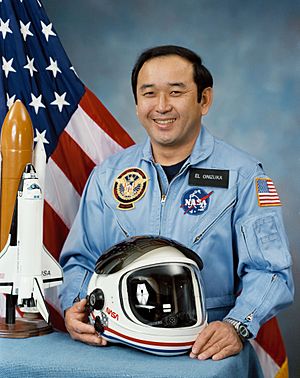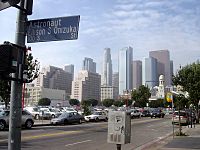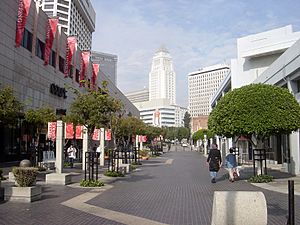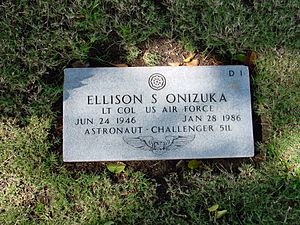Ellison Onizuka facts for kids
Quick facts for kids
Ellison Onizuka
|
|
|---|---|

Onizuka, c. 1980
|
|
| Born |
Ellison Shoji Onizuka
June 24, 1946 |
| Died | January 28, 1986 (aged 39) North Atlantic Ocean
|
| Alma mater | University of Colorado at Boulder |
| Occupation | Research engineer |
| Awards | Congressional Space Medal of Honor |
| Space career | |
| NASA astronaut | |
| Rank | |
|
Time in space
|
3d 01h 33m |
| Selection | 1978 NASA Group 8 |
| Missions | STS-51-C, STS-51-L (disaster) |
|
Mission insignia
|
|
Ellison Shoji Onizuka (エリソン・ショージ・オニヅカ, 鬼塚 承次, Onizuka Shōji, June 24, 1946 – January 28, 1986) was an American astronaut and engineer. He was also a Flight test engineer for the U.S. Air Force (USAF). Born in Kealakekua, Hawaii, he successfully flew into space aboard the Space Shuttle Discovery.
Ellison Onizuka tragically died in the destruction of the Space Shuttle Challenger. He was serving as a Mission Specialist for mission STS-51-L. He holds the distinction of being the first Asian American and the first person of Japanese origin to travel to space.
Contents
Early Life and Education
Ellison Onizuka was born on June 24, 1946. He was the oldest son of Masamitsu and Mitsue Onizuka. Growing up, Ellison was very active in groups like FFA, 4-H, and the Boy Scouts of America. He even achieved the highest rank in Boy Scouts, becoming an Eagle Scout.
He finished high school at Konawaena High School in 1964. Ellison then went to the University of Colorado at Boulder. In 1969, he earned two degrees: a Bachelor of Science and a Master of Science, both in Aerospace Engineering. While at college, he was part of the U.S. Air Force ROTC.
On June 7, 1969, Ellison married Lorna Leiko Yoshida. They had two daughters, Janelle and Darien.
Air Force Career
Ellison Onizuka began his active duty with the United States Air Force on January 15, 1970. He worked as a flight test engineer at McClellan Air Force Base. In this role, he helped test many different types of aircraft.
From 1974 to 1975, Onizuka attended the U.S. Air Force Test Pilot School. After that, he was assigned to Edwards Air Force Base in California. He became a flight test engineer there, helping to manage and instruct on various aircraft used for testing. During his time in the Air Force, he logged over 1,700 hours of flight time.
NASA Career and Space Missions
Onizuka was chosen to join the astronaut program in January 1978. After a year of training, he became a full-fledged astronaut in August 1979. At NASA, he worked on important software for the Space Shuttle.
His first journey into space was on January 24, 1985. He flew on the Space Shuttle Discovery for mission STS-51-C. This was a special mission for the Department of Defense. Onizuka was in charge of deploying a special upper stage from the shuttle. After orbiting the Earth 48 times, Discovery landed on January 27, 1985. Ellison Onizuka spent a total of 74 hours in space on this mission.
Ellison Onizuka's next mission was STS-51-L on the Space Shuttle Challenger. The shuttle launched from Kennedy Space Center on January 28, 1986. Just 73 seconds after liftoff, the Challenger broke apart. All seven crew members, including Onizuka, sadly lost their lives.
After the accident, investigators found that some emergency air packs in the cockpit had been activated. This suggested that Onizuka and some other crew members might have been alive for a short time after the cockpit separated. However, the cabin would have lost pressure, and the packs alone could not have saved them during the rapid descent.
Ellison Onizuka was buried at the National Memorial Cemetery of the Pacific in Honolulu, Hawaii. He was promoted to the rank of colonel after his death.
Awards and Honors
Ellison Onizuka was a member of several professional organizations, including the Society of Flight Test Engineers and the American Institute of Aeronautics and Astronautics.
He received many awards for his service, such as the Air Force Meritorious Service Medal and the NASA Space Flight Medal. After his death, he was given the Congressional Space Medal of Honor, a very high award for astronauts.
Legacy and Memorials
Many places and things have been named in honor of Ellison Onizuka:
- Onizuka Air Force Station in Sunnyvale, California, and family housing at Hickam Air Force Base.
- The Ellison S. Onizuka Space Center at Kona International Airport in Hawaiʻi. This center closed in 2016, but some items are now displayed at the Japanese Cultural Center of Hawaii.
- An asteroid (3355 Onizuka) and a crater on the Moon (Onizuka crater).
- The Cygnus NG-16 ISS resupply spacecraft was named S.S. Ellison Onizuka.
- A street in Little Tokyo, Los Angeles, California, and another street in Clear Lake City, Houston, Texas.
- The Onizuka Memorial Library at Whitcomb Elementary School, where his daughters attended.
- The Onizuka Center for International Astronomy in Hawaii, which supports the Mauna Kea Observatories.
- A conference room at the University of Colorado at Boulder.
- A quotation from Ellison Onizuka is printed in every new standard U.S. passport.
- Annual "Astronaut Ellison Onizuka Science Day" events are held at the University of Hawai'i-Hilo and El Camino College.
- The airport in his home district of Kona was renamed Ellison Onizuka Kona International Airport at Keāhole in 2017.

A soccer ball that Ellison Onizuka took into space on the Challenger was recovered after the accident. It was given to him by the soccer team he coached. This ball is now on display at Clear Lake High School. In 2016, astronaut Robert Kimbrough took the same soccer ball back into space on the ISS.

In Media
- Ellison Onizuka was played by actor Keone Young in the 1990 TV movie Challenger.
- In the TV show Star Trek: The Next Generation, a small shuttlecraft on the starship Enterprise is named after Onizuka.
See also
 In Spanish: Ellison Onizuka para niños
In Spanish: Ellison Onizuka para niños
- List of Asian American astronauts


